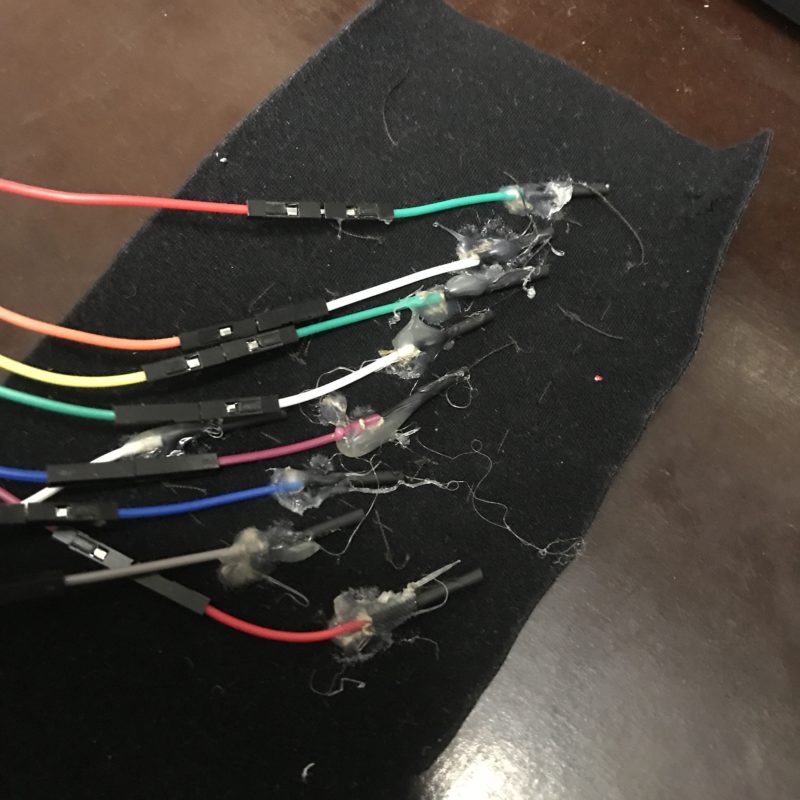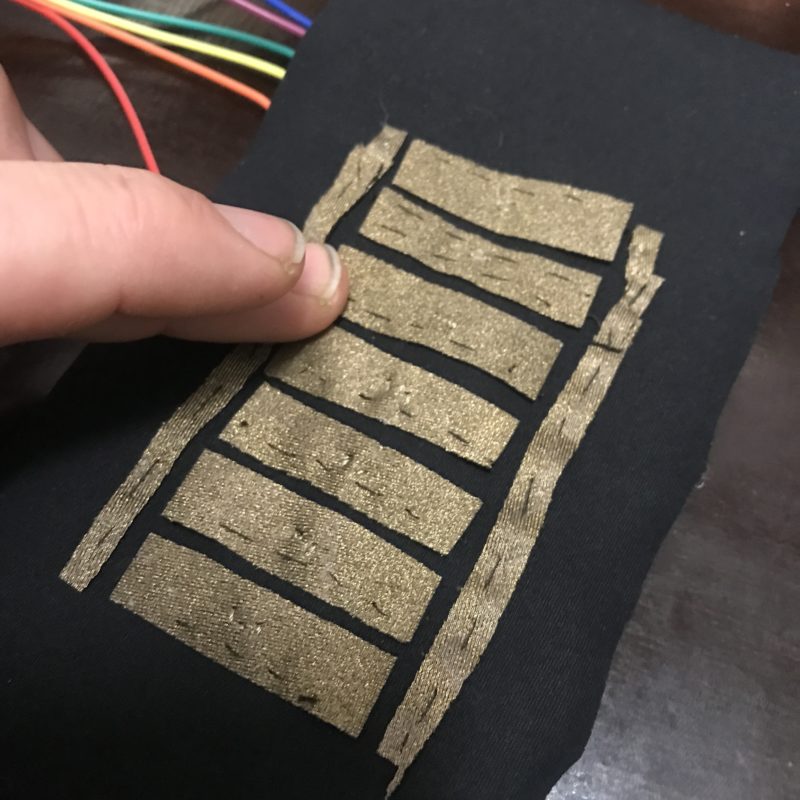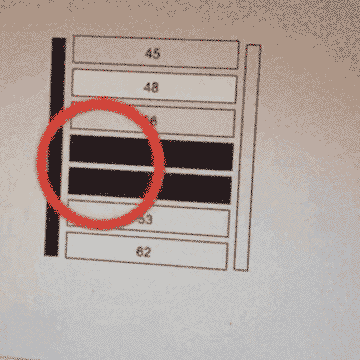This example demostrates a pretty simple 1,5dimensional textile matrix piped to Processing via direct serial connection. The matrix is based on the ESP32 touchpins (9!) which values are interpolated by a simple smooth function on the microcontroller.
This example shows how to utilize a simple textile matrix to get something like a touchpad control. The matrix might be much more detailed for sure, but this comes with a lot of complications in production and durability. So let’s keep it simple and sustainable somehow.



ESP32 Code
This code smoothly reads out all touchpins with a custom class. Check out for previous posts – we will publish it properly in the future :=)
// ----------------------------------
// -------MAIN LOOP -----------------
// ----------------------------------
// get all the defaultly available capacitive touchpins ( GPIO on ESP32 )
aTouch touch1(2);
aTouch touch2(4);
aTouch touch3(15);
aTouch touch4(13);
aTouch touch5(12);
aTouch touch6(14);
aTouch touch7(27);
aTouch touch8(33);
aTouch touch9(32);
void setup() {
Serial.begin(9600);
Serial.println("0,0,0,0,0,0,0,0,0");
}
void loop() {
// simply read input and do some calc
touch1.readAndProcessInput();
touch2.readAndProcessInput();
touch3.readAndProcessInput();
touch4.readAndProcessInput();
touch5.readAndProcessInput();
touch6.readAndProcessInput();
touch7.readAndProcessInput();
touch8.readAndProcessInput();
touch9.readAndProcessInput();
// print all values directly to console or for visualization in PROCESSING
Serial.print(touch1.smoothed_val);
Serial.print(",");
Serial.print(touch2.smoothed_val);
Serial.print(",");
Serial.print(touch3.smoothed_val);
Serial.print(",");
Serial.print(touch4.smoothed_val);
Serial.print(",");
Serial.print(touch5.smoothed_val);
Serial.print(",");
Serial.print(touch6.smoothed_val);
Serial.print(",");
Serial.print(touch7.smoothed_val);
Serial.print(",");
Serial.print(touch8.smoothed_val);
Serial.print(",");
Serial.println(touch9.smoothed_val);
delay(20);
}
Processing Code
Keep in mind = This code is a early, uncleaned, pin-hardcoded proof of concept. Check for learning is pretty welcome!
import processing.serial.*;
int t1_val = 0;
int t2_val = 0;
int t3_val = 0;
int t4_val = 0;
int t5_val = 0;
int t6_val = 0;
int t7_val = 0;
int t8_val = 0;
int t9_val = 0;
Serial myPort;
int pad = 30;
void setup () {
size(400, 400); // window size
ellipseMode(CENTER);
rectMode(CENTER);
// println(Serial.list());
String portName = Serial.list()[0];
myPort = new Serial(this, portName, 9600);
myPort.bufferUntil('\n');
myPort.write('s');
textAlign(CENTER,CENTER);
}
void serialEvent (Serial myPort) {
try {
operateSerial(myPort);
}
catch(RuntimeException e) {
e.printStackTrace();
}
}
void operateSerial(Serial myport) {
String portData = myport.readString();
String[] stringData = split(portData, ',');
float[] values = float(stringData);
t1_val = int(values[0]);
t2_val = int(values[1]);
t3_val = int(values[2]);
t4_val = int(values[3]);
t5_val = int(values[4]);
t6_val = int(values[5]);
t7_val = int(values[6]);
t8_val = int(values[7]);
t9_val = int(values[8]);
}
int padx = 60;
int pady = 30;
int ifw = 150;
int ifh = 24;
float yu = height/2-100+pady*4.3 ;
void draw() {
background(222);
strokeWeight(1);
stroke(22);
// left sidebar ----------
fill(t4_val*5);
rect(width/2 - ifw/1.7, height/2, 12, 200 );
// right sidebar ----------
fill(t2_val*5);
rect(width/2 + ifw/1.7, height/2, 12, 200 );
// bar 1 ----------
fill(t1_val*5);
rect(width/2, pady+yu, ifw, ifh );
fill(0);
text(t1_val,width/2, pady+yu);
// bar 2 ----------
fill(t3_val*5);
rect(width/2, pady*2+yu, ifw, ifh );
fill(0);
text(t3_val,width/2, pady*2+yu);
// bar 3 ----------
fill(t5_val*5);
rect(width/2, pady*3+yu, ifw, ifh );
fill(0);
text(t5_val,width/2, pady*3+yu);
// bar 4 ----------
fill(t9_val*5);
rect(width/2, pady*4+yu, ifw, ifh );
fill(0);
text(t9_val,width/2, pady*4+yu);
// bar 5 ----------
fill(t8_val*5);
rect(width/2, pady*5+yu, ifw, ifh );
fill(0);
text(t8_val,width/2, pady*5+yu);
// bar 6 ----------
fill(t7_val*5);
rect(width/2, pady*6+yu, ifw, ifh );
fill(0);
text(t7_val,width/2, pady*6+yu);
// bar 7 ----------
fill(t6_val*5);
rect(width/2, pady*7+yu, ifw, ifh );
fill(0);
text(t6_val,width/2, pady*7+yu);
float tap_amount = (tick+tickx) ;
noFill();
stroke(255,22,22);
strokeWeight(1+( tap_amount)*3);
ellipse(width/2+spos.x*50,spos.y*200+100,111,111);
calcSingleCursor();
}
PVector spos = new PVector();
PVector tpos = new PVector();
int tickx = 0;
int tick = 0;
void calcSingleCursor(){
float midy = 0;
float midx = 0;
tickx = 0;
tick = 0;
if( t4_val < 30){
midx += -1; tickx++;
}
if( t2_val < 30){
midx += 1; tickx++;
}
if(tickx > 0){
midx /= float(tickx);
tpos.x = midx;
}else{
tpos.x *=.9;
}
// OPERATE Y AXIS! ------------------
if( t1_val < 30){
midy += 0; tick++;
}
if( t3_val < 30){
midy += 0.143; tick++;
}
if( t5_val < 30){
midy += 0.286; tick++;
}
if( t9_val < 30){
midy += .5; tick++;
}
if( t8_val < 30){
midy += 0.643; tick++;
}
if( t7_val < 30){
midy += 0.786; tick++;
}
if( t6_val < 30){
midy += 1.; tick++;
}
midy /= float(tick);
if(tick>0){
tpos.y= midy;
}
spos = PVector.lerp(spos,tpos,.2);
}

